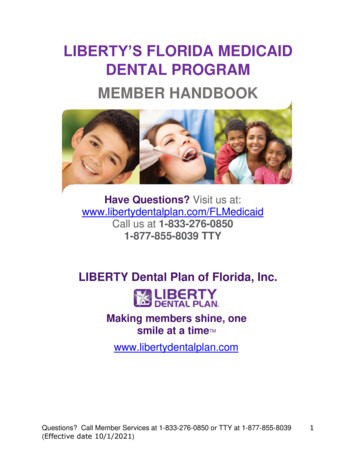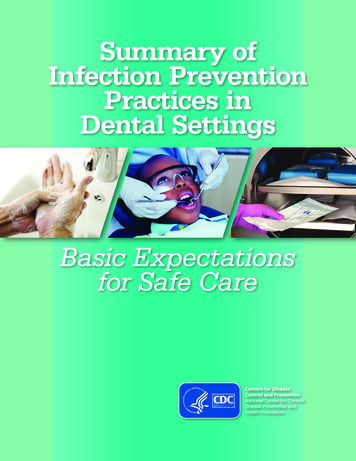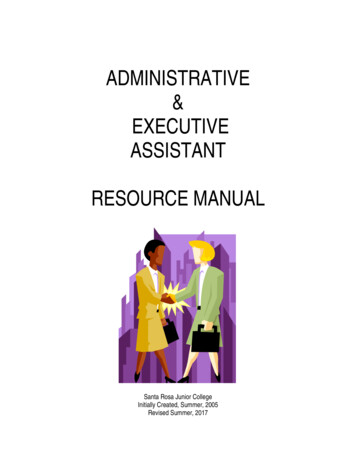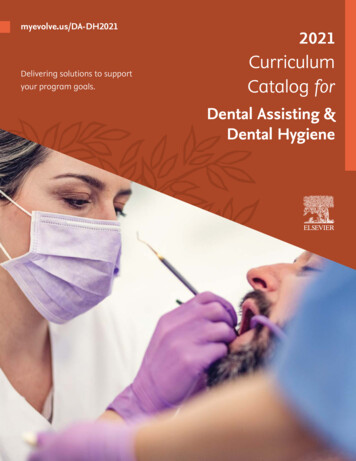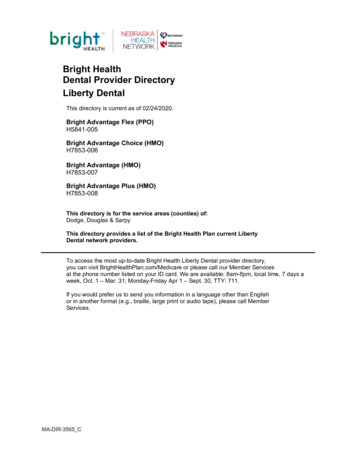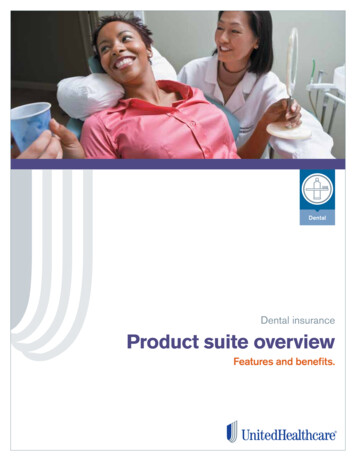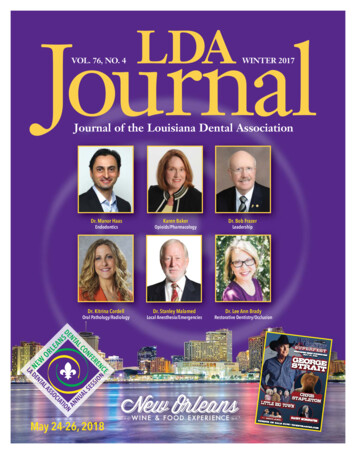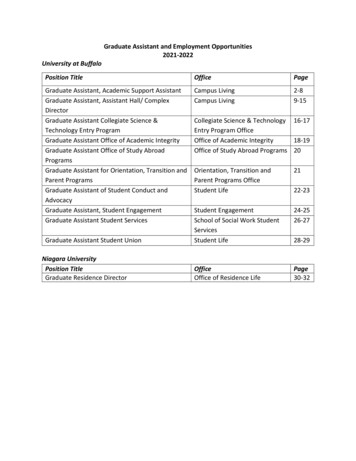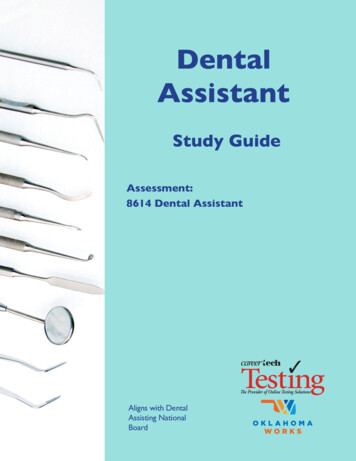
Transcription
DentalAssistantStudy GuideAssessment:8614 Dental AssistantAligns with DentalAssisting NationalBoard
OverviewThis study guide is designed to help students prepare for the Dental Assisting assessment. It not onlyincludes information about the assessment, but also the skills standards upon which the assessmentis based, resources that can be used to prepare for the assessment and test taking strategies. Theassessment measures a student’s ability to apply knowledge of the skills necessary for success in thedental assisting field.Each of the four sections in this guide provides useful information for students preparing for the DentalAssisting assessment. CareerTech and Competency-Based Education: A Winning Combination Dental Assisting assessment Assessment Information Standards and Test Content Sample Questions National Certification Exam Crosswalk Abbreviations, Symbols, and Acronyms Strategies for Test Taking Success NotesThis assessment’s standards are aligned with those of the Dental Assisting National Board (DANB). TheDANB’s Certified Dental Assistant (CDA) is administered in three tests: General Chairside Assisting,Radiation Health and Safety and Infection Control. The CTTC assessment covers these three componentsin one assessment. The DANB was founded in 1948 and is the national certification board for dentalassistants. DANB, a nonprofit organization, is a member of the Institute for Credentialing Excellence (ICE).ICE: www.credentialingexcellence.orgDANB: www.danb.orgDisclaimerThe Oklahoma Department of Career and Technology Education cannot vouch for the accuracy of theinformation contained in any linked site. Our intent is to simply provide a list of sites that we feel maybe useful to you. Some of the links presented here are commercial sites. We do not endorse these sitesor their products, and we do not request or accept any fee for inclusion on this list. The Departmentmakes no representations or warranties, express or implied, with respect to the document, or anypart thereof, including any warrantees of title, noninfringement of copyright or patent rights of others,merchantability, or fitness or suitability for any purpose.Equal Opportunity/Non Discrimination StatementThe Oklahoma Department of Career and Technology Education does not discriminate on the basis ofrace, color, national origin, sex/gender, age, disability, or veteran status. Inquiries concerning applicationof this policy may be referred to the ODCTE Compliance Coordinator, 1500 W. 7th Ave. Stillwater, OK74074-4364, or call 1-800 522-5810 or (405) 377-2000.2
CareerTech and Competency-Based Education:A Winning CombinationCompetency-based education uses learning outcomes that emphasize both the application and creationof knowledge and the mastery of skills critical for success. In a competency-based education system,students advance upon mastery of competencies, which are measurable, transferable outcomes thatempower students.Career and technology education uses industry professionals and certification standards to identifythe knowledge and skills needed to master an occupation. This input provides the foundation fordevelopment of curriculum, assessments and other instructional materials needed to prepare studentsfor wealth-generating occupations and produce comprehensively trained, highly skilled employeesdemanded by the work force.Tools for SuccessCareerTech education relies on three basic instructional components to deliver competency-basedinstruction: skills standards, curriculum materials, and competency assessments.Skills standards provide the foundation for competency-based instruction and outline theknowledge and skills that must be mastered in order to perform related jobs within an industry. Skillsstandards are aligned with national skills standards and/or industry certification requirements; therefore,a student trained to the skills standards is equally employable in local, state and national job markets.Curriculum materials and textbooks contain information and activities that teach studentsthe knowledge and skills outlined in the skills standards. In addition to complementing classroominstruction, curriculum resources include supplemental activities that enhance learning by providingopportunities to apply knowledge and demonstrate skills.Certification Assessments test the student over material outlined in the skills standards andtaught using the curriculum materials and textbooks. When used with classroom performanceevaluations, certification assessments provide a means of measuring occupational readiness.Each of these components satisfies a unique purpose in competency-based education and reinforces theknowledge and skills students need to gain employment and succeed on the job.Measuring SuccessEvaluation is an important component of competency-based education. Pre-training assessmentsmeasure the student's existing knowledge prior to receiving instruction and ensure the student'straining builds upon this knowledge base. Formative assessments administered throughout the trainingprocess provide a means of continuously monitoring the student's progress towards mastery.Certification assessments provide a means of evaluating the student’s mastery of knowledge and skills.Coaching reports communicate assessment scores to students and provide a breakdown of assessmentresults by standard area. The coaching report also shows how well the student has mastered skillsneeded to perform major job functions and identifies areas of job responsibility that may requireadditional instruction and/or training.3
Dental Assisting AssessmentAssessments InformationWhat is the Dental Assisting assessment?The Dental Assisting assessment is an end-of-program assessment for students in dental assistingprograms. The assessment provides an indication of student mastery of knowledge and conceptsnecessary for success in careers in this area.How were the assessments developed?The assessment was developed by the CareerTech Testing Center. The assessment and standards alignwith the Dental Assisting National Board (DANB) standards. Items were developed and reviewed by acommittee of subject matter experts.The committee assigned frequency and criticality ratings to each skill, which determines the significanceof each task for test development: Frequency: represents how often the task is performed on the job. Frequency rating scalesvary for different occupations. The rating scale used in this publication is presented below:1 less than once a week2 at least once a week3 once or more a day Criticality: denotes the level of consequence associated with performing a task incorrectly.The rating scale used in this publication is presented below:1 slight2 moderate3 extremeWhat do the assessments cover?The test includes multiple-choice test items over the following areas:Dental Assisting (100 questions)Collect and Record Clinical DataPerform Chairside Dental ProceduresPrepare and Apply Chairside Dental MaterialsPerform Laboratory ProceduresProvide Patient EducationPrevent and Manage Emergencies3%17%9%7%6%8%Perform Office OperationsPractice the Legal Aspects of DentistryPromote Infection ControlPromote Occupational SafetyPromote Radiation Health and SafetyPromote Professionalism3%3%11%8%22%3%What are the benefits of using this assessment?Students receive a certificate for each assessment that he/she passes. This certificate may be includedin his/her portfolio and used to communicate the student’s mastery of the subject matter to potentialemployers.4
When should the assessment be taken?The CareerTech Testing Center recommends that students take this assessment as soon as possibleafter receiving all standards-related instruction, rather than waiting until the end of the school year.Are the assessments timed?No. However, most students finish the assessment within one hour.What resources can students use on these assessments?Students are allowed to use calculators and scratch paper on CTTC assessments; however, these items mustbe provided by the testing proctor and returned to the proctor before the student’s exam is submitted forscoring. Calculator apps on cell phones and other devices may not be used on these assessments.What accommodations can be made for students withIndividualized Education Plans (IEPs)?Accommodations are allowed for students with an Individualized Education Plan. Examples of allowableaccommodations include: Extended time — This assessment is not timed; therefore, students may take as much time asneeded to finish. The assessment must be completed in one testing session. Readers — A reader may be used to read the assessment to a student who has been identified asneeding this accommodation. Enlarged text — Students needing this accommodation can activate this feature by clicking theicon in the upper right corner of the screen.What can students expect on Test Day?All CTTC assessments are web-based and delivered exclusively by a proctor in the school’s assessmentcenter. The proctor cannot be an instructor or anyone who was involved with the student duringinstruction.Assessments are delivered in a question-by-question format. When a question is presented, the studentcan select a response or leave the question unanswered and advance to the next question. Studentsmay also flag questions to revisit before the test is scored. All questions must be answered before thetest can be submitted for scoring.After the assessment is scored, the student will receive a score report that not only shows the student’sscore on the assessment, but also how the student performed in each standard area.Can students retake the test?Students may retake the test unless their school or state testing policies prohibit retesting. Studentswho can retest must wait at least three days between test attempts.5
Standards and Test ContentCollect and Record Clinical Data (3 questions)1. Conduct preliminary interview and examination of patient. (3/3) Interview patient for purpose of patient’s visit and/or chief complaint. Review patient’s medical history and update records.‣ Contraindications‣ Tobacco use A ssess patient’s general physical condition and note anyabnormalities. I dentify and locate the types of teeth in the primary andpermanent dentition. I dentify, describe and note any abnormal findings in the head andneck regions. Common oral diseases (canker sores, fever blister, etc.) Dental hygiene-related problems2. Perform charting functions. (3/3) Record patient information and treatment in progress notes. I dentify the permanent and primary teeth according to theUniversal Numbering System. C hart conditions in the patient’s oral cavity and accuratelyrecord data using standard charting techniques:‣ Observe/record suspected decayed teeth.‣ Record periodontal conditions (mobility, furcation involvement,inflammation, and pocket depth). Record treatment plan. Obtain informed consent. Use common dental software.3. Use diagnostic aids. (3/3) P repare for and assist with the collection of diagnostic data (i.e.,radiographs, pulp tests, intraoral and extraoral photographs,occlusal registrations, intraoral camera). Take, pour, and trim impressions for diagnostic study casts.4. Assess vital signs. (1/3) ake and record pulse rate and description.TO bserve and record respiration rate.M easure and record blood pressure. Take and record temperature.6
Perform Chairside Dental Procedures (17 questions)1. Prepare operatory. (3/3) P repare the treatment room to receive and treat the patient (includes infection control andbarrier techniques). P repare appropriate treatment trays with instruments in sequence of use and delivery position. S eat and prepare patient; position and adjust equipment.2. Select and prepare armamentarium. (3/3) Select and prepare tray set-ups and all necessary instruments for general dentistry anddental emergency own and bridgeRoot canalOral laxis3. Perform or assist with intraoral procedures. (3/3) Demonstrate four-handed dentistry concepts in all treatmentprocedures.‣ Assume correct positions.‣ Perform instrument transfers.‣ Maintain access and visibility for treatment procedures. Maintain field of operation during dental procedures through theuse of retraction, rinsing, suction, irrigation, drying, etc. Place and remove cotton rolls. Apply and/or assist with intraoral procedures.‣‣‣‣‣‣‣PolishTopical fluorideVitality testMinor bleedingTemporary and/or excess cementDental damMatrix bands Assist with and/or apply topical anesthetic to site of injection. Assist with and/or monitor the administration of nitrous oxide/oxygen analgesia. Indentify and exchange rotary instruments in dental hand pieces.4. Use patient management techniques. (3/3) Calm and reassure patient.Display professional attitude with all patients. Accommodate patients with special needs.Monitor patient during procedures.7
Prepare and Apply Chairside Dental Materials (9 questions)1. Prepare for and assist with impressions. (3/3) Prepare, mix, deliver and store the following materials for impressions: Irreversible hydrocolloid (alginate) Elastomeric (polyether, polyvinylsiloxane)2. Prepare for and assist with restoratives. (3/3) Prepare, mix, deliver and store restorative materials sitesTemporary restorative materialsBases/linersEtchantsBonding agents Prepare and/or seat temporary crowns.Perform Laboratory Procedures (7 questions)1. Select and prepare materials. (3/3) Gypsum products Dental waxes Acrylic products or acrylic substitutes2. Properly store gypsum and acrylic products and dental waxes. (3/3)3. Fabricate and evaluate diagnostic casts, including trimming and finishing. (3/3)4. Fabricate bleaching trays and mouth guards. (2/3)5. Clean and polish fixed and removable appliances and prostheses. (2/3)Provide Patient Education (6 questions)1. Provide information on personal oral habits that may compromise general health. (3/3)2. Provide pre/post treatment instruction. (3/3) Explain, clarify and provide written instructions on the procedures and services being delivered.3. Explain plaque control techniques. (3/3) Evaluate the patient’s oral health care status and habits. Provide preventative oral health care information to the patient based on individual needs. Instruct the patient in appropriate toothbrush selection and brushing techniques.4. Explain nutrition and its effect on dental health. (3/3) Provide instruction and evaluate basic nutritional needs of individual patients as they relate todental health. Explain to the patient the relationship of carbohydrates to the development of dental caries.8
Prevent and Manage Emergencies (8 questions)1. Take actions to prevent medical emergencies based on the patient’s medical history. (3/3)2. Recognize and assist with medical emergencies. (2/3) Recognize the signs and symptoms related to medical conditions/emergencies. Assemble and maintain appropriate emergency supplies, drugs and equipment. Locate and follow office emergency procedures.3. Describe the dental assistant’s responsibility during dental emergencies. (1/3) Don’t panic. Notify the dentist and follow instructions.4. Perform first aid and/or CPR. (1/3) Use Automated External DefibrillatorPerform Office Operations (3 questions)1. Maintain and control supplies. (2/3) Record and inventory items used. Order supplies, instruments and equipment to maintain specifiedlevels. Rotate expendable/non-expendable supplies according to theexpiration dates and the inventory control system.2. Maintain dental equipment/instruments. (3/3) Perform maintenance on the equipment and instruments as permanufacturers’ instructions. Properly care for and store supplies.3. Communicate effectively and establish good working relationshipswith patients and other members of the dental care team. (3/3) Use good telephone etiquette. Greet and dismiss patients and visitors. Use the appointment control process.4. Perform minor accounting functions. (3/3) Explain fees. Explain basic concepts of third-party payment. Use dental office software.9
Practice the Legal Aspects of Dentistry (3 questions)1. Explain legal responsibilities and regulations. (2/3) Explain the patient’s right to privacy and confidentiality.‣ HIPAA Explain the legal responsibilities of the dental assistant in relation to the State Dental Practice Act.‣ Scope of practice2. Maintain records in accordance with legal guidelines. (3/3) Identify the legal significance of the patient’s chart.Follow procedures necessary to release copies of patient records.File items into individual patient records (i.e., radiographs, histories, correspondence)Record patient telephone communication and professional dental and medical consultations.Document informed consent or refusal of recommended treatment.Promote Infection Control (11 questions)1. Maintain and document a quality assurance program for infection control throughout the dental office. (2/3)2. Explain the rationale for infection control procedure (Health Care Team/patient). (2/3) Explain the need for vaccination against infectious diseases. Identify the modes of disease transmission.3. Follow Standard Precautions for the prevention of disease transmission. (3/3) Prevent cross-contamination and disease transmission.‣ Perform proper hand washing.‣ Use disposable items whenever possible.‣ Protect the patient and operator through theuse of barrier techniques including masks, gloves,protective eyewear, clinic attire and other safetyitems.‣ Properly dispose of biohazardous and other waste.‣ Properly store all instruments. Perform sterilization procedures.‣ P repare dental instruments and equipment forsterilization.‣ Use the appropriate method ofr sterilization ofdental instruments, equipment and supplies. Perform disinfection procedures.‣ U se the proper method of disinfection for thetreatment room, equipment and other appropriatematerials.‣ Prepare chemical agents according tomanufacturers’ instructions.10
Promote Occupational Safety (8 questions)1. Follow the standard guidelines of occupational safety for dental office personnel. (3/3) Use chemical agents according to OSHA standards including proper labeling. Maintain and update Material Safety Data Sheets (MSDS) on all applicable materials. Document and report all exposures.2. Discuss the necessary steps to follow should an exposure occur. (3/3)3. Understand the importance of proper body mechanics. (3/3)4. Demonstrate proper body mechanics. (3/3) Lifting techniquesErgonomics Posture Chair positionPatient transfersPromote Radiation Health and Safety (22 questions)1. Expose radiographs. (3/3) Select appropriate radiographic technique. S elect appropriate film or imaging device,placement devices, cotton rolls, cassettes,infection control barriers, lead aprons andthyroid collar. Practice infection control techniques. Expose dental films, using various lPhosphorSensors2. Process radiographs. (3/3) Prepare, maintain, and replenish radiographic solutions for manual and automatic processors. P rocess exposed intra and extraoral radiographs by use of manual, automatic or scanningtechniques. Practice infection control techniques.3. Evaluate radiographs for errors and retake if necessary. (3/3)4. Mount radiographs. (3/3) Identify anatomical structures and dental materials on radiographs. Label patient information on radiographs. Prepare radiographs for viewing, filing and duplication.5. Practice safety measures to protect the patient from radiation. (3/3)11
6. Practice safety measures to protect the operator and dental team from radiation. (3/3) Describe techniques for monitoring individual radiation exposure.7. Explain proper storage and disposal of supplies. (3/3) Discuss proper temperature, humidity, radiation protection and inventory control for film storage. P roperly store chemical agents used in radiography procedures according to the local regulatoryagency, in compliance with the OSHA Hazard Communication Standard. Properly dispose of all chemical agents and other materials. Discuss proper storage and handling of imaging devices.8. Explain quality assurance guidelines. (3/3) I mplement quality assurance procedure, including daily monitoring of solution temperatures,dates of solution changes, test film runs, etc.Promote Professionalism (3 questions)1. Demonstrate appropriate appearance (3/3) ttireAH ygieneD ental healthP ersonal habits (i.e. smoking)2. Pursue continuing education opportunities (1/3)3. Create a resume (1/3)4. Describe requirements for obtaining/maintaining professionaldesignation (1/3) C ertified Dental Assistant E xpanded function Dental Assistant5. Identify advanced training and certification opportunities fordental assistants (1/3) C oronal polishing/fluoride applicationN itrous oxideR adiation safetyS ealants6. Demonstrate employability skills (3/3) ttendance/observance of work hoursAP rofessional communication (grammar) TeamworkP roblem solvingC ritical thinking12
Sample Questions 1. Which of the following procedures involves applying a plastic-like coating over theocclusal pits and grooves of the teeth?A.B.C.D. 2. When trimming a diagnostic cast on a model trimmer, the dental assistant should:A.B.C.D. call the EPA to report the spill.clean up and dispose of the mercury in the trash can.make a report and tell the dentist.use a spill kit, a mask and utility gloves to clean up the spill.5. X-ray positioning instruments and bite-blocks that are placed in the patient’s mouth are:A.B.C.D. sharps receptaclehazardous waste baginfectious waste bagtrash can4. If a small mercury spill occurs in the dental office, the assistant should:A.B.C.D. trim the models in occlusion.rotate the model continuously.trim the model dry.use water in the trimmer.3. Which of the following containers is used for the disposal of contaminated needlesand broken glass?A.B.C.D. dental sealantsdisclosing agentfluoride treatmentprophylaxiscritical items that require heat sterilization.non-critical items that can be disinfected and reused.semi-critical items that can be disinfected and reused.semi-critical items that are disposable or sterilized before reuse.6. The three types of x-ray film are:A.B.C.D.D, E and F.intraoral, extraoral and duplicating.intraoral, extraoral and panoramic.one-, two- and three-film packets.13
7. What is the universal sign for choking?A.B.C.D. 8. A positive telephone image is developed by speaking:A.B.C.D. coughinggrasping the throatquick breathsexhaling rapidlyin dental terms.loudly.softlyin a pleasing voice.9. Proper body mechanics can:A.B.C.D.result in strains.prevent injuries.increase back pain.cause stress. 10. A disinfectant is used to:A.B.C.D.destroy most disease-causing microorganisms.kill all microbes.destroy most organisms.kill all macroorganisms.14
Sample Questions — Key1. Which of the following procedures involves applying a plastic-like coating over the occlusal pitsand grooves of the teeth?A.B.C.D.dental sealantsdisclosing agentfluoride treatmentprophylaxisCorrect by definitionIncorrect by definitionIncorrect by definitionIncorrect by definition2. When trimming a diagnostic cast on a model trimmer, the dental assistant should:A.B.C.D.trim the models in occlusion.rotate the model continuously.trim the model dry.use water in the trimmer.IncorrectIncorrectIncorrectCorrect3. Which of the following containers is used for the disposal of contaminated needles and brokenglass?A.B.C.D.sharps receptaclehazardous waste baginfectious waste bagtrash canCorrect by definitionIncorrect by definitionIncorrect by definitionIncorrect by definition4. If a small mercury spill occurs in the dental office, the assistant should:A.B.C.D.call the EPA to report the spill.clean up and dispose of the mercury in the trash can.make a report and tell the dentist.use a spill kit, a mask and utility gloves to clean up the spill.Wrong, but plausibleWrong, but plausibleWrong, but plausibleCorrect5. X-ray positioning instruments and bite-blocks that are placed in the patient’s mouth are:A.B.C.D.critical items that require heat sterilization.non-critical items that can be disinfected and reused.semi-critical items that can be disinfected and reused.semi-critical items that are disposable or sterilized before reuse.6. The three types of x-ray film are:A.B.C.D.D, E and F.intraoral, extraoral and duplicating.intraoral, extraoral and panoramic.one-, two- and three-film packets.Wrong, but plausibleCorrectWrong, but plausibleWrong, but plausible15IncorrectIncorrectIncorrectCorrect
7. What is the universal sign for choking?A.B.C.D.coughinggrasping the throatquick breathsexhaling rapidlyIncorrect by definitionCorrect by definitionIncorrect by definitionIncorrect by definition8. A positive telephone image is developed by speaking:A.B.C.D.in dental terms.Incorrectloudly. Incorrectsoftly Incorrectin a pleasing voice.Correct9. Proper body mechanics can:A.B.C.D.result in strains.prevent injuries.increase back pain.cause stress.IncorrectCorrectIncorrectIncorrect10. A disinfectant is used to:A.B.C.D.destroy most disease-causing microorganisms.Correct by definitionkill all microbes. Incorrect by definitiondestroy most organisms.Incorrect by definitionkill all macroorganisms.Incorrect by definition16
National Certification Exam CrosswalkThe chart below displays items on the CareerTech Testing Center's Dental Assisting assessment, whichare crosswalked to the Dental Assisting National Board assessment.GC — General ChairsideICE — Infection ControlRHS — Radiation Health and SafetyTaskCorrect and Record Clinical DataConduct preliminary interview and examination of patientPerform charting functionsUse diagnostic aidsAssess vital signsPerform Chairside Dental ProceduresPrepare operatorySelect and prepare armamentariumPerform or assist with intra-oral proceduresUse patient management techniquesPrepare and Apply Chairside Dental MaterialsPrepare for and assist with impressionsPrepare for and assist with restorativesPerform Laboratory ProceduresSelect and prepare materialsProperly store gypsum and acrylic products and dental waxesFabricate and evaluate diagnostic casts, including trimming and finishingFabricate bleaching trays and mouth guardsClean and polish fixed and removable appliances and prosthesesProvide Patient EducationProvide information on personal oral habits that may compromise general healthProvide pre/post treatment instructionExplain plaque control techniquesExplain nutrition and its effect on dental healthPrevent and Manage EmergenciesTake actions to prevent medical emergenciesRecognize and assist with medical emergenciesDescribe the dental assistant’s responsibility during dental emergenciesPerform first aid and CPR17Dental AssistingNational C
TaskPerform Office OperationsMaintain and control suppliesMaintain dental equipment/instrumentsCommunicate effectively and establish good working relationships with patientsand with other members of the dental care teamPerform minor accounting functionsUnderstand the Legal Aspects of DentistryExplain legal responsibilities and regulationsMaintain records in accordance with legal guidelinesPromote Infection ControlMaintain and document a quality assurance program for infection controlthroughout the dental officeDiscuss patient and dental health care worker educationFollow Standard Precautions for the prevention of disease transmissionPromote Occupational SafetyFollow the standards and guidelines of occupational safety for dental office personnelIncorporate personal safety measures when using toxic materials or irritantsUnderstand the importance of proper body mechanicsDemonstrate proper body mechanicsPromote Radiation Health and SafetyExpose radiographsProcess radiographsEvaluate radiographs for errors and retake if necessaryMount radiographsPractice safety measures to protect the patient from radiationPractice safety measures to protect the operator from radiation18Dental AssistingNational RHSRHS
Abbreviations, Symbols and AcronymsThe following is a list of abbreviations, symbols, and acronyms used in the Dental Assistant study guideand on the Dental Assistant assessment.3DThree-dimensionalDegree/ Either or" Inches% PercentALARA As low as reasonably achievableBMI Body Mass IndexCAB Compressions, Airway, BreathingCDA Certified Dental AssistantCPR Cardiopulmonary ResuscitationCTTC Career Tech Testing CenterDANB Dental Assisting National BoardEMT Emergency Medical TechnicianEPA Environmental Protection AgencyHBV Hepatitis B VirusHCV Hepatitis C VirusHepB Hepatitis BHIPAA Health Insurance Portability and Accountability ActHIV Human Immune Deficiency VirusICE Institute for Credentialing ExcellenceIEP Individualized Education PlankVp KilovoltsMSDS Material Safety Data SheetsOSHA Occupational Safety and Health AdministrationPPE Personal Protective EquipmentXCP Extension Cone ParallelingX-Ray X Radiationo19
Test Taking StrategiesThis section of the study guide contains valuable information for testing success and provides acommon-sense approach for preparing for and performing well on any test.General Testing Advice1. Get a good night’s rest the night before the test – eight hours of sleep is recommended.2. Avoid junk food and “eat right” several days before the test.3. Do not drink a lot or eat a large meal prior to testing.4. Be confident in your knowledge and skills!5. Relax and try to ignore distractio
Dental Assistant Study Guide Aligns with Dental Assisting National Board Assessment: . The Dental Assisting assessment is an end-of-program assessment for students in dental assisting programs. The assessment provides an indication of student mastery of knowledge and conc
